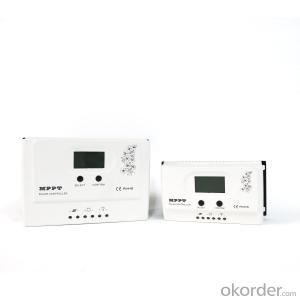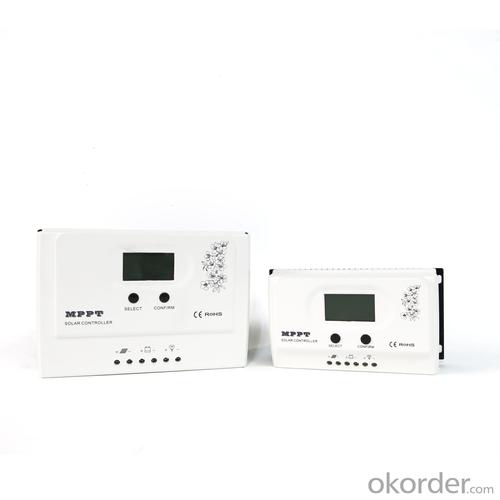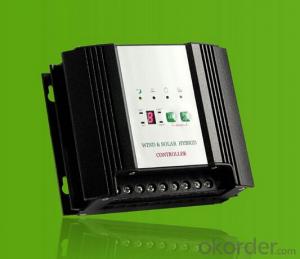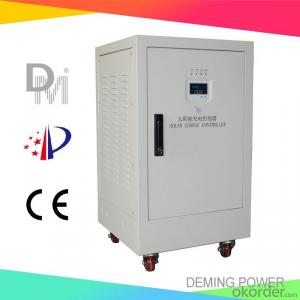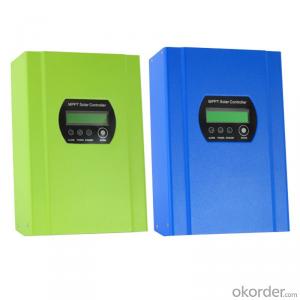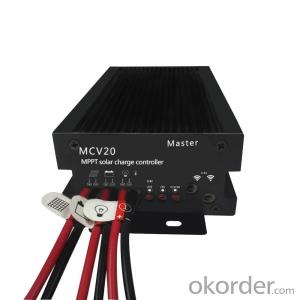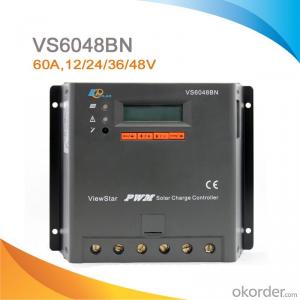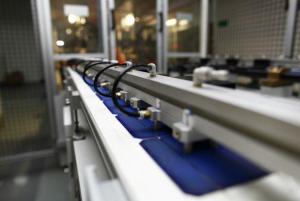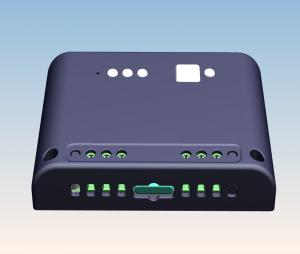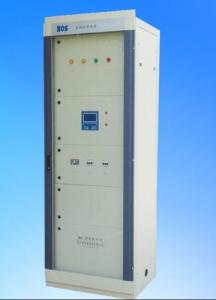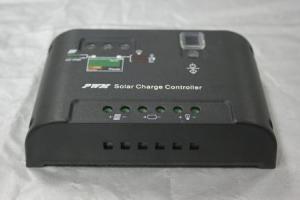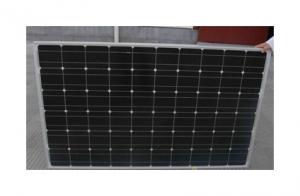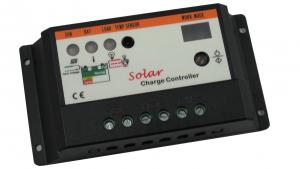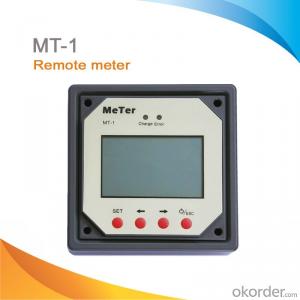Plasmatronics Solar Controllers - Max. PV Input 100V Solar Charge 12V/24V Controller 15A MPPT with LCD
- Loading Port:
- China main port
- Payment Terms:
- TT OR LC
- Min Order Qty:
- 20 unit
- Supply Capability:
- 9999 unit/month
OKorder Service Pledge
OKorder Financial Service
You Might Also Like
Max. PV Input 150V Solar Charge 12V/24V Controller 15A 20A 30A 40A 50A MPPT with LCD
I-P-Wiser 1 series adopted with auto cool, high conversion efficiency, LCD display and free PC software. It features an efficient MPPT control algorithm to track the maximum power point of the PV array in any environment. Greatly improve the utilization of solar panel. Also added the output function(USB 5V 3A). For the mppt controller can be widely used in off-grid solar system, Communication base station solar system, household solar systems, street light solar systems, field monitoring and other fields.
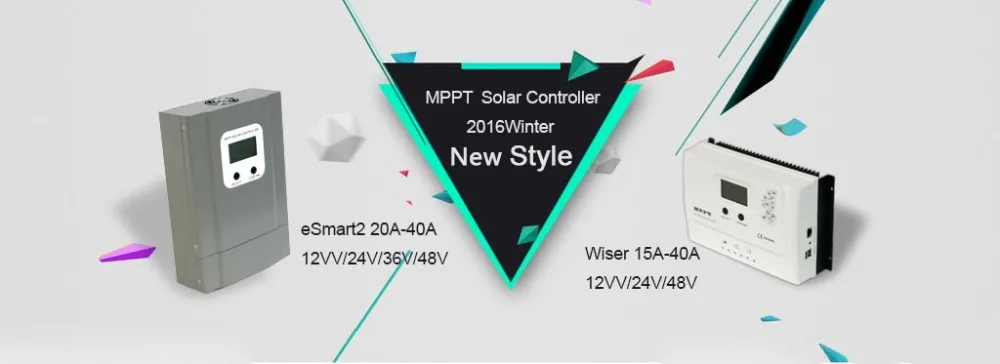
| Product Show |
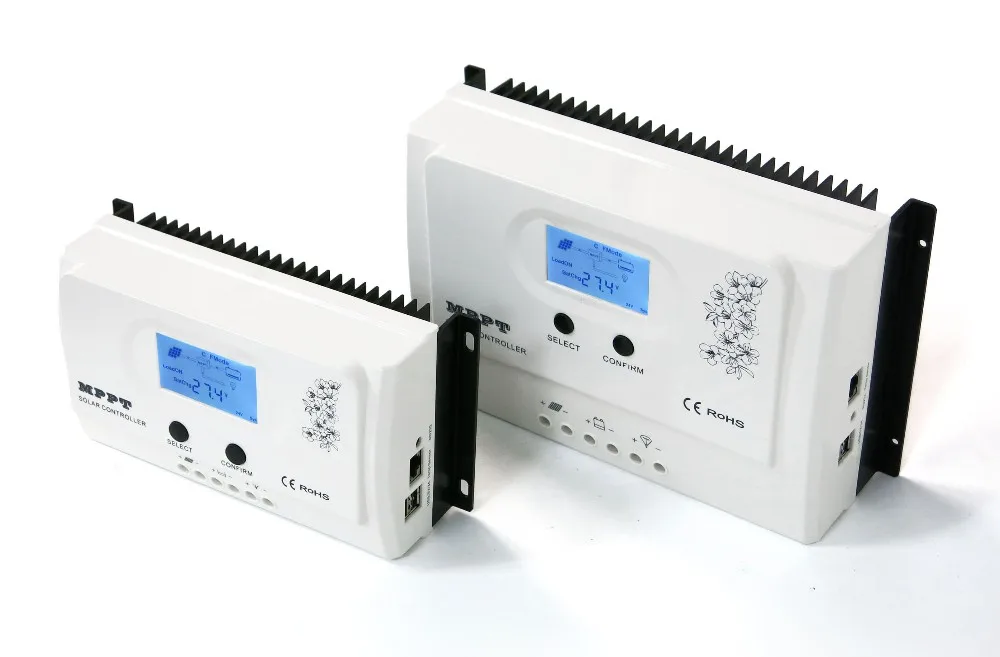
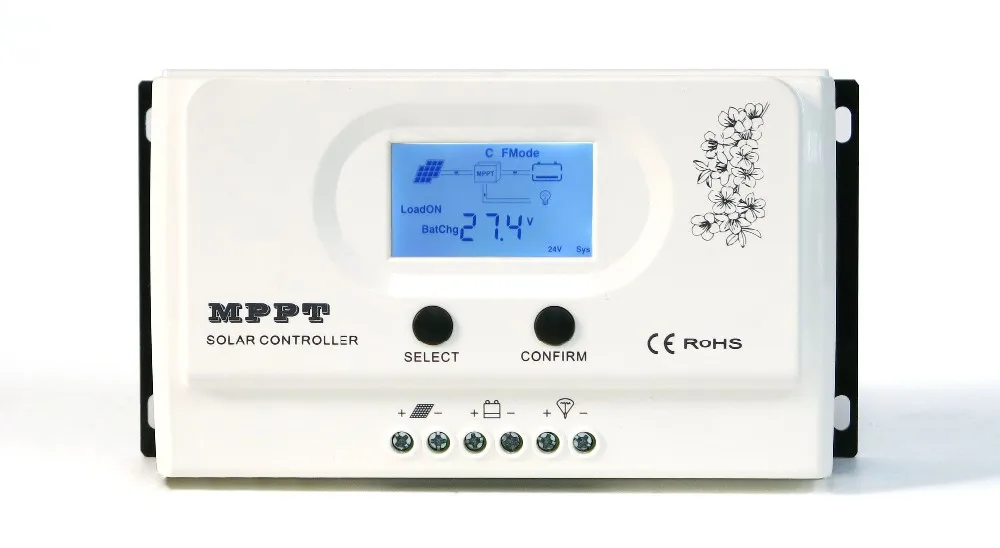
| MPPT Controller connection diagram |
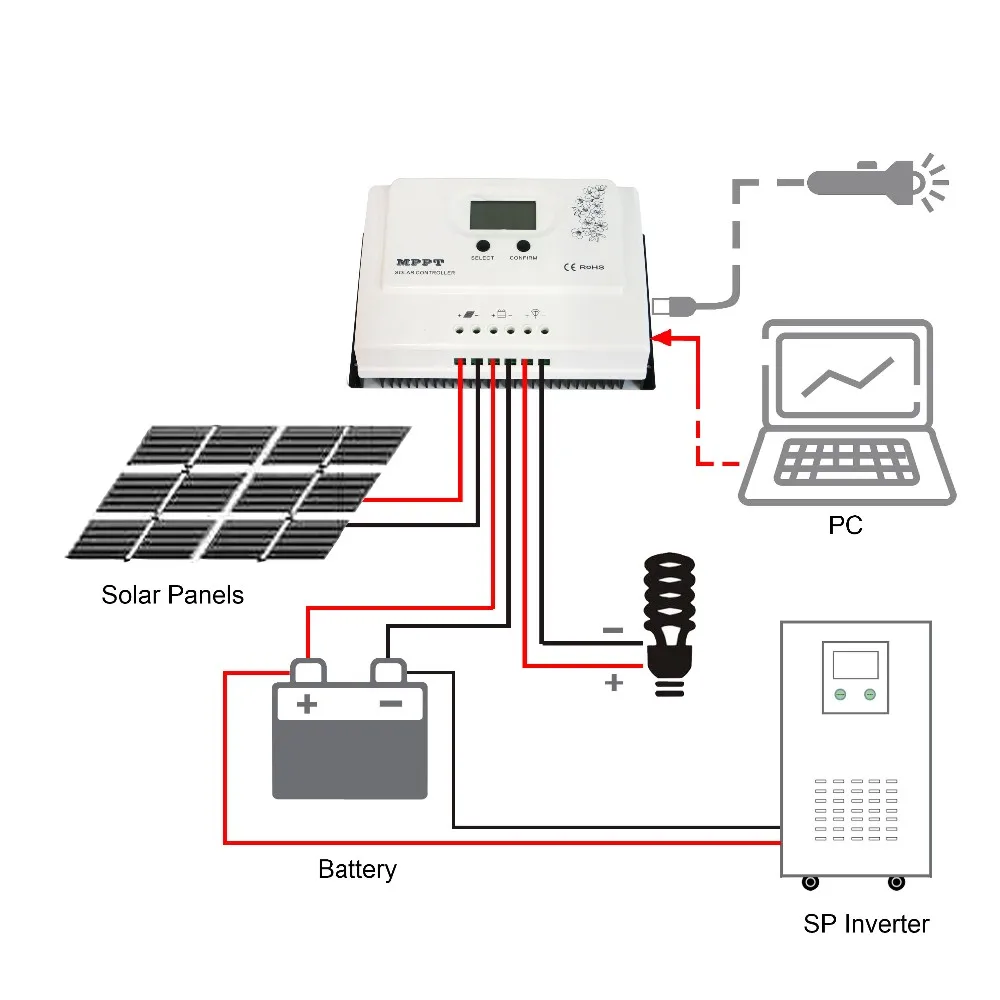
| Features |
1.High efficiency MPPT control algorithm, MPPT efficiency ≥99.5%, whole Machine conversion efficiency upto 98%;
2.12V/24V system Automatic Recognition,users can use it in different system conveniently.
3.Maximum PV input voltage: 100VDC(15A, 20A), 150VDC (30A, 40A,50A)
4.Charge mode: three stages (fast charge, constant charge, floating charge). It prolongs service life of the batteries.
5.Discharge mode: ON/OFF mode, PV voltage control mode.
6.Recommended battery types: sealed lead acid, vented, gel, NiCd battery. Other types of the batteries can also be defined.
7.Most information could be provided by LCD like: system type., PV input voltage, battery type, battery voltage, charging current, charging power, working status and so on. Also customer's information like company name, website and logo can be added into Solar Eagle software.
8.RS232 communication, we can offer communication protocol also, it’s convenient for user’s integration management.
9.CE, RoHS, FCC certifications approved.. We can help clients to approve other certifications.
10.2 years warranty. And 3~10 years extended warranty service also can be provided.
Upper Computer Software and Test Software |
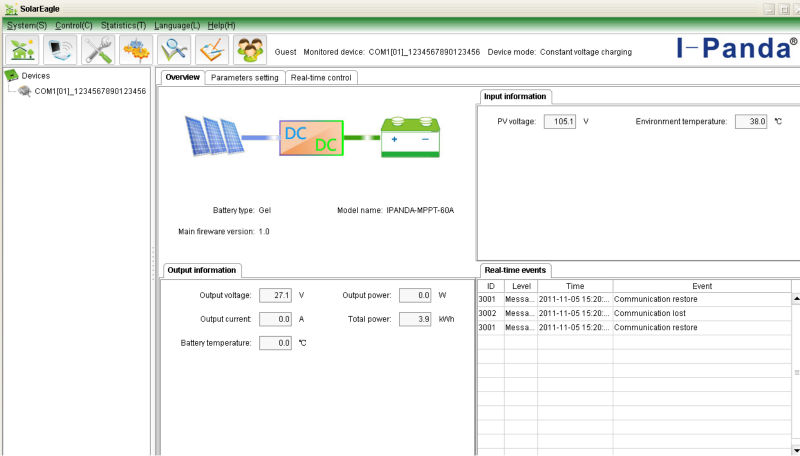
PC software_SolarEagle
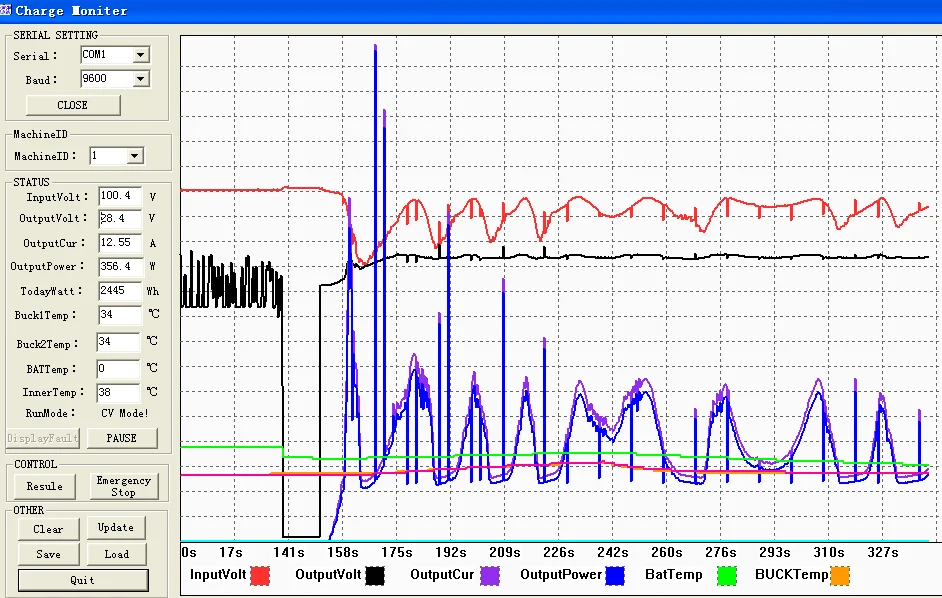
Monitoring software
Visual display of charge and discharge status, PV voltage, charge voltage, charge current, and can set the battery type, LOAD output control;
parameters |
Model: | 15A | 20A | 30A | 40A | 50A | |
I-P-Wiser 1-12V/24V-Series | ||||||
Charge mode | MPPT(maximum power point tracking) | |||||
MPPT efficiency | ≥99.5% | |||||
System type | DC12V/24V system | Automatic Recognition | ||||
INPUT CHARACTERISTICS | ||||||
PV Max PV input voltage(VOC) | 12V/24V system | DC100V | DC150V | |||
Start the charging voltage point | 12V system | 18V | ||||
24V system | 32V | |||||
High input voltage protection point | 12V/24V system | DC100V | DC150V | |||
High input voltage recovery point | 12V/24V system | DC95V | DC145V | |||
Rated PV power | 12V system | 200W | 260W | 390W | 520W | 650W |
24V system | 400W | 520W | 780W | 1040W | 1300W | |
CHARGE CHRECTRESTICS | ||||||
Selectable Battery Types | 12V/24V system | Sealed lead-acid batteries, Vented batteries Gel, NiCd battery (Other types of the batteries also can be defined) | ||||
Charge method | 12V/24V system | Three stages charge: constant current(MPPT), constant voltage, floating charge | ||||
Charge rated current | 12V/24V system | 15A | 20A | 30A | 40A | 50A |
OUTPUT DISCHARGE CHARACTERISTICS | ||||||
USB (Total for 2 USB output) | DC5V 3A | |||||
LOAD output voltage | Based on battery voltage | |||||
Max. DC Load current | 30A | |||||
Output control mode | ON/OFF mode, PV voltage control mode | |||||
Output control set way | Controller button or PC software | |||||
DISPLAY | ||||||
LCD Display | System type, PV voltage,charge voltage, charging current, charging power, temperature etc. | |||||
PC software | RS232 | |||||
OTHER PARAMETERS | ||||||
Protection function | Yes (Over voltage, low voltage, over temperature, over load, Short circuit protection etc.) | |||||
Cooling mode | Auto cool | |||||
Type of Mechanical Protection | IP 30 | |||||
Measurement DxWxH (mm) | 200*110*66 | 243*155*79 | ||||
Packing DxWxH (mm) | 249*144*105 | 289*189*113 | ||||
N.W. (KG) | 0.9 | 1.8 | ||||
G.W. (KG) | 1.3 | 2.2 | ||||
Certifications |
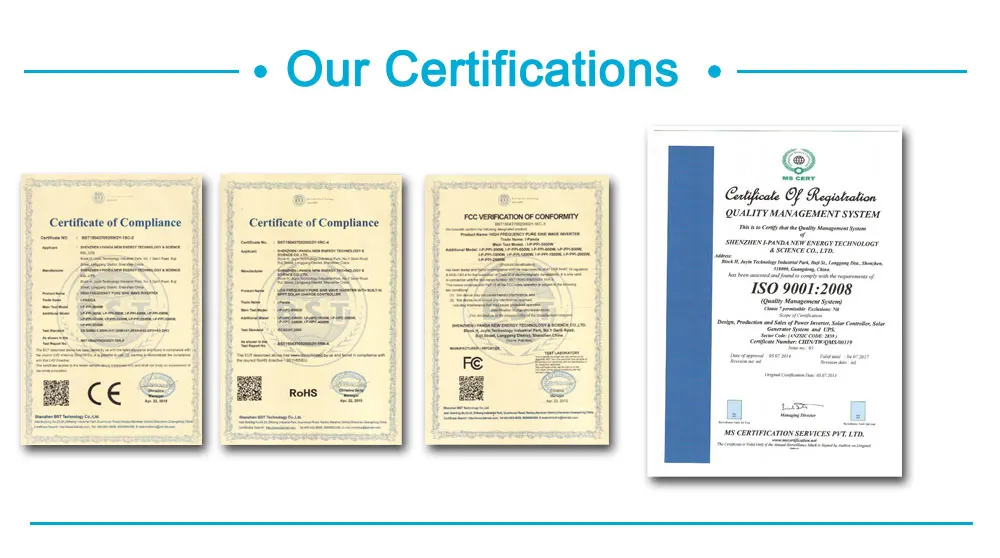
F&Q: |
Q1. How to ensure and monitor the products quality?
A1: We have established a perfect Quality Management System, In strict
accordance with ISO9001: 2008 quality system and ISO14001 environment system for quality assurance management;
Our ISO9001:2008 Quality System certificate encoding: CHIN/TW/QMS/00119;
Our ISO14001 Environment System certificate encoding: CHIN/TW/EMS/00028;
Q2. What is the warranty of products?
A2: The warranty period of different products are different; 5 years, 3 years, 2 years, 1 years; More details please refer to the product specification or manual; we will provide free life-long technical support ;
Q3. What is the difference between MPPT&PWM?
A3. MPPT charging mode, peak efficiency up to 99%, saving 30%~60% solar panel than traditional PWM controller.
- Q: How do PWM solar controllers differ from MPPT solar controllers?
- PWM (Pulse Width Modulation) solar controllers and MPPT (Maximum Power Point Tracking) solar controllers differ in their methods of regulating and optimizing the charging and output of solar panels. PWM solar controllers work by rapidly switching the connected solar panels between the battery bank and charge/discharge cycles. They regulate the charge rate by adjusting the width of the pulses, effectively controlling the voltage output. However, PWM controllers do not actively track the maximum power point of the solar panels, resulting in lower efficiency and reduced energy harvest, especially in cold or cloudy conditions. On the other hand, MPPT solar controllers utilize advanced algorithms to actively track and adjust the operating point of the solar panels to maximize power output. By continuously adjusting the voltage and current, MPPT controllers match the output of the solar panels to the battery bank's charging requirements more efficiently. This enables MPPT controllers to extract more power from the solar panels, especially in low light or non-optimal temperature conditions. Consequently, MPPT controllers are generally more efficient and effective at utilizing the available solar energy.
- Q: Can a solar controller be used in a solar-powered outdoor signage system?
- Yes, a solar controller can definitely be used in a solar-powered outdoor signage system. A solar controller helps regulate and optimize the charging and discharging of the batteries in the system, ensuring efficient and reliable operation of the signage. It helps protect the batteries from overcharging and over-discharging, which can significantly extend their lifespan. Additionally, a solar controller can help monitor and display the charging status and performance of the solar panels, allowing for better management and maintenance of the outdoor signage system.
- Q: Can a solar controller be used in hybrid systems?
- Yes, a solar controller can be used in hybrid systems. A solar controller is used to regulate the charging and discharging of a solar battery bank, ensuring that it operates efficiently and safely. In a hybrid system, which combines multiple sources of energy such as solar, wind, and grid power, a solar controller can play a crucial role in managing the flow of energy from the solar panels to the battery bank. It can monitor the voltage and current generated by the solar panels and adjust the charging parameters accordingly. Additionally, a solar controller can also provide important data and statistics about the solar energy production in a hybrid system, allowing for better monitoring and optimization of the overall energy generation and consumption. Therefore, a solar controller is a valuable component that can be successfully integrated into hybrid systems to enhance their performance and efficiency.
- Q: Can a solar controller be used with solar-powered indoor healthcare institutions?
- Yes, a solar controller can be used with solar-powered indoor healthcare institutions. A solar controller is essential for managing and regulating the power generated by solar panels, ensuring optimal charging and protection of batteries. In healthcare institutions, solar power can be used to provide electricity for lighting, medical equipment, and other essential functions, reducing reliance on the grid and ensuring uninterrupted power supply.
- Q: Can a solar controller be used with solar panels that have different orientations?
- Yes, a solar controller can be used with solar panels that have different orientations. The primary function of a solar controller is to regulate the flow of energy between the solar panels and the battery or load. It monitors the voltage and current coming from the solar panels and ensures that the battery is charged efficiently and safely. While it is generally recommended to have solar panels facing the sun directly for maximum efficiency, it is still possible to use panels with different orientations. In such cases, the solar controller will adjust the charging parameters to accommodate the varying input from the panels. It will optimize the charging process by adjusting the voltage and current levels to match the battery's requirements. However, it is important to note that using panels with different orientations may affect the overall efficiency and performance of the solar system. The total output power will be determined by the panel with the least optimal orientation. Therefore, it is advisable to install solar panels with similar orientations to maximize the overall energy production. In conclusion, a solar controller can be used with solar panels that have different orientations, but it may result in reduced efficiency and performance. It is best to have panels facing the sun directly for optimal energy production.
- Q: How does a solar controller handle shading or partial obstruction of solar panels?
- The use of Maximum Power Point Tracking (MPPT) technology allows a solar controller to effectively manage shading or partial obstruction of solar panels. MPPT constantly adjusts the voltage and current of the panel to maintain optimal performance. When a solar panel is partially shaded or obstructed, less sunlight reaches the panel, resulting in decreased power generation. This can have a significant impact on the overall efficiency of the solar system. However, a solar controller equipped with MPPT capability can minimize these effects and ensure the highest power output. MPPT-enabled solar controllers utilize advanced algorithms and circuitry to continuously monitor the voltage and current of the panel. By actively tracking the panel's maximum power point, the controller optimizes operating conditions to maximize power output, even in the presence of shading or obstruction. When shading occurs, the MPPT controller detects changes in voltage and current and adjusts the operating point accordingly. It dynamically identifies the new maximum power point and maintains the panel's output at or close to its optimal level, compensating for the shaded areas. This allows the system to extract the maximum amount of energy from available sunlight, ensuring high efficiency and power generation. Furthermore, advanced MPPT controllers may employ partial shading algorithms that can identify specific shaded areas on the panel and allocate power generation resources accordingly. These algorithms may reconfigure the panel's connection or adjust its electrical characteristics to bypass shaded areas, further optimizing power output. In conclusion, a solar controller with MPPT capability effectively manages shading or partial obstruction of solar panels by continuously adjusting operating conditions to maximize power output. This ensures that the solar system generates the highest possible energy, even in less-than-ideal conditions.
- Q: Can a solar controller be used with a solar-powered outdoor Wi-Fi system?
- A solar-powered outdoor Wi-Fi system can indeed utilize a solar controller. This device plays a crucial role in regulating the energy flow from the solar panels to the batteries, ensuring their proper and efficient charging. When it comes to a solar-powered outdoor Wi-Fi system, the solar controller takes on the responsibility of managing the energy supply, ensuring that the batteries are charged throughout the daylight hours and enabling the system to function even in the absence of sunlight. This capability empowers the Wi-Fi system to operate continuously, even in remote or off-grid areas where conventional power sources may not be accessible. By incorporating a solar controller into a solar-powered outdoor Wi-Fi system, it becomes feasible to harness the sun's power to offer reliable and sustainable connectivity.
- Q: Can a solar controller be used with flexible solar panels?
- Yes, a solar controller can be used with flexible solar panels. The solar controller regulates the flow of electricity from the panels to the battery, and it is compatible with both rigid and flexible panels.
- Q: How do I determine the correct wire size for a solar controller?
- To determine the correct wire size for a solar controller, you need to consider a few factors. Firstly, you need to determine the maximum current that will be passing through the wire. This can be calculated by multiplying the maximum voltage of the solar controller by the maximum current output. Once you have the maximum current, you can refer to a wire size chart, which provides the recommended wire gauge based on the current rating. These charts are readily available online or at most electrical supply stores. It's important to note that wire size is typically measured in American Wire Gauge (AWG), where a smaller number represents a larger wire size. For example, a wire size of 2 AWG is larger than a wire size of 10 AWG. In addition to the current rating, you should also consider the length of the wire run. Longer wire runs result in higher resistance, leading to voltage drop. To mitigate this, you may need to choose a larger wire size to compensate for the distance. It's always recommended to err on the side of caution and choose a wire size that can handle slightly more current than what is expected. This ensures that the wire is not overloaded and minimizes the risk of overheating or damage. Lastly, it's crucial to follow any local electrical codes or regulations that may dictate the minimum wire size required for solar installations. These codes are in place to ensure safety and prevent any potential hazards. Overall, determining the correct wire size for a solar controller involves calculating the maximum current, referring to a wire size chart, considering the wire run length, and following any applicable electrical codes.
- Q: Can a solar controller be used with solar-powered indoor parking facilities?
- Yes, a solar controller can be used with solar-powered indoor parking facilities. Solar controllers are designed to regulate the flow of electricity between the solar panels and the batteries, ensuring optimal charging and preventing overcharging. In solar-powered indoor parking facilities, the solar controller would play a crucial role in managing the energy generated by the solar panels and efficiently storing it in the batteries for later use.
Send your message to us
Plasmatronics Solar Controllers - Max. PV Input 100V Solar Charge 12V/24V Controller 15A MPPT with LCD
- Loading Port:
- China main port
- Payment Terms:
- TT OR LC
- Min Order Qty:
- 20 unit
- Supply Capability:
- 9999 unit/month
OKorder Service Pledge
OKorder Financial Service
Similar products
Hot products
Hot Searches
Related keywords
